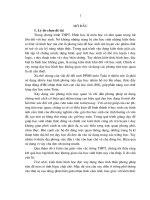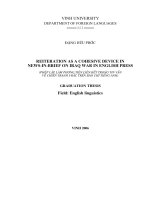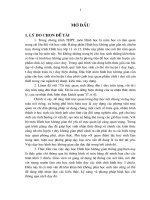Mệnh đề điều kiện được sử dụng làm phương tiện rào đón trong tiếng Anh và tương đương của chúng trong tiếng Việt nghiên cứu trên bình diện dụng học
Bạn đang xem bản rút gọn của tài liệu. Xem và tải ngay bản đầy đủ của tài liệu tại đây (212.04 KB, 8 trang )
Mệnh đề điều kiện được sử dụng làm phương
tiện rào đón trong tiếng Anh và tương đương
của chúng trong tiếng Việt: nghiên cứu trên bình
diện dụng học
Ngô Thị Minh Trang
Trường Đại học Ngoại ngữ
Luận văn ThS ngành: Ngôn Ngữ Anh; Mã số: 60 22 15
Người hướng dẫn: Dr. Ngô Hữu Hoàng
Năm bảo vệ: 2012
Abstract: Numerous studies have been carried out to investigate English conditionals in
light of syntactics and semantics; however, limited research has been done to evaluate the
pragmatic functions of conditionals, particularly in Vietnamese context. This study,
therefore, is done with an aim to offer a detailed analysis of conditionals in light of
pragmatics. The study employed a qualitative approach through data collection and
analysis from a well-known novella. The data then were quantitatively converted into
numeric patterns as the primary basis for organizing and reporting results. The findings of
the study show that conditional clauses are not only used in English for referring to real
as well as hypothetical conditions and their consequences but can be also used as a
hedging device to issue politeness, especially in spoken contexts, where the if-clause
often stands alone and is independent of the main clause. Hopefully, this study would
offer both theoretical & practical contribution on the area of pragmatic studies
particularly on analyzing conditionals used in language basing on the Cooperative
Principle and Politeness Theory. Theoretically, this study is hoped to broaden the
understanding of pragmatic functions of conditional in real communication. It is also
expected that the findings in this study will give a direct contribution to the existing
knowledge in the field of pragmatic studies. Practically, the researcher hopes that this
study can provide the educators with the appropriate explanations of pseudo-conditionals
such as “If you like…, If I may interrupt…” to their students. Additionally, this study
could offer learners some ways to express politeness in communication by using pseudo-
conditionals. Likewise, this research is expected to give the foundation and an important
direction for those who are interested in translating English conditionals into Vietnamese
ones.
Keywords: Tiếng Anh; Tiếng Việt; Mệnh đề điều kiện; Giao tiếp
Content
PART A: INTRODUCTION
1. Rationale of the Study
In consideration of the importance of conditionals in teaching and learning English as
well as the fact that limited research has been done to evaluate pragmatic functions of
conditionals, especially in Vietnamese context, the researcher has decided to undertake the study
entitled “Conditional Clauses Used as Hedges in English and Vietnamese Equivalents: a
Pragmatic Perspective” in order to provide the more comprehensive analysis on conditionals
regarding pragmatic point of view.
2. Objectives of the Study
In brief, the study addresses the following primary objectives:
a. To distinguish the conditionals as hedging devices from true conditionals
b. To identify the pragmatic functions of If-hedging comparing to Vietnamese
equivalents
c. To suggest some implications for teaching, learning and translating English
conditional sentences
3. Methods of the study
Such methods as descriptive, comparative and contrastive were employed to describe and
analyze, to compare and contrast the database in order to explore similarities and differences in
using English conditionals and Vietnamese equivalents. A qualitative approach was also
conducted to discover meanings that emerge after careful documentation and thoughtful analysis
for over approximately a five-month period. The data were quantitatively converted into numeric
patterns as the primary basis for organizing and reporting results.
PART B: DEVELOPMENT
CHAPTER I: THEORETICAL BACKGROUND
This chapter provides the theoretical background of the thesis. It is divided into four main
sections; section 1 discusses the concept of Hedging, section 2 presents Cooperative Principles,
section 3 focuses on the Politeness Strategies, and section 4 deals with the concept of Conditionals.
1. The Concept of Hedging
1.1. Definitions of Hedge
1.2. Forms of Hedges
1.3. Functions of Hedges
2. Cooperative Principle
3. Politeness Theory
3.1. Politeness and Face
3.2. Face Saving Acts versus Face Threatening Acts
3.3. Grice’s Cooperative Principle and Brown and Levinson’s Politeness Theory
4. The Concept of Conditionals
4.1. Definition of Conditional Sentences
4.2. True Conditionals
4.3. Pseudo-Conditionals
CHAPTER 2: “IF” HEDGING AND POLITENESS
This chapter analyzes the pragmatic functions of pseudo-conditionals as hedging devices in
English and Vietnamese basing on Grice’s theory of Cooperative Principle and Brown and
Levinson’s theory of Politeness Principle.
2.1. If-hedging and Cooperative Principle
2.1.1. If-hedging and Maxim of Quality
2.1.2. If-hedging and Maxim of Quantity
2.1.3. If-hedging and Maxim of Relation
2.1.4. If-hedging and Maxim of Manner
2.2. If-hedging and Politeness Principle
CHAPTER 3: DATA ANALYSIS AND FINDINGS
This chapter provides an analysis of the conditionals which are extracted from The Little
Princess. The data will be analyzed according to the following aspects:
- True Conditionals and Pseudo-Conditionals Occurrence Rate
- Pragmatic Functions of Pseudo-Conditionals in English and Vietnamese Equivalents
- Suggestions on Teaching and Learning English Conditionals
- Suggestions on Translating English Conditionals
PART C: CONCLUSION
After analyzing the research findings and the discussion in the preceding part, conclusion,
limitations and some suggestions are taken. .
1. Conclusions
In grammar’s point of view, conditional clause refers to the condition under which the
speaker makes the utterance. In pragmatics’ point of view, conditional clauses are not only used to
mention real as well as hypothetical conditions and their consequences but also used as a
hedging device to perform pragmatic functions, especially in spoken contexts, where the If-
clauses often stand alone and are independent of the main clauses.
In general, pseudo-conditionals are purposely employed with the intention of softening the
foregoing part of the utterance that might be viewed as imposition. The speakers use the pseudo-
conditionals as the form of a redress with an aim to soften the impact of the message to listeners; by
this means serving the purpose of politeness.
Another important thing is to deal with the suggestions for teachers to teach conditionals at
school. To improve the communicative competence of students, initially, teachers have to help their
students identify the pragmatic functions that conditionals express.
Remarkably, the study is of great linguistic value since it has explored some approaches of
studying English conditional sentences in light of pragmatics and some ways to help Vietnamese
learners of English overcome the difficulties in translating English conditionals into Vietnamese and
vice versa.
Furthermore, in the last part of the thesis, Vietnamese learners of English can be provided
with useful knowledge that can help them know how to perform a pseudo-conditional effectively in
communication.
2. LIMITATIONS
First of all, data were collected only within a period of five months; this time constraint was
determinant for the way in which data was collected. Also, the data were collected from one novella
consisting of 27 chapters; therefore, the findings discussed in this study cannot be generalized for the
occurrence rate of conditionals. Moreover, because of the same constraint, the researcher was able to
gather only examples from If-clauses, while more other conditional structures would have certainly
enabled the researcher to draw a more detailed picture of actual conditionals. Next, this study was
guided by a simple research design whose aim was to begin to understand the pragmatic functions of
pseudo-conditionals in linguistics and communication.
3. SUGGESTIONS FOR FURTHER STUDY
The researcher will conduct a research of conditionals in the spoken discourse with a corpus-
based approach. That will offer her a chance to observe and analyze great amounts of data, thereby
ensuring a higher degree of representativeness.
References
Vietnamese:
1. Nguyễn Tấn Đại, (2001), Hoàng Tử Bé (Trans.), Nhà xuất bản Hội Nhà Văn, TP.
HCM
2. Lê Thị Minh Hằng, (2009), Câu Điều Kiện Tiếng Việt dưới góc độ ngữ dụng,
Retrieved from the website:
English:
1. Akatsuka N. (1986), Conditionals are discourse bound, Cambridge University Press.
2. Austin J. L. (1962), How to do Things with Words, Oxford, Oxford University Press.
3. Bonano M. (1982), Women’s language in the medical interview, Linguistics and the
Professions, Norwood, N.J: Ablex.
4. Brown P., Levinson S. C. (1987), Politeness: Some Universals in Language Use,
Cambridge, Cambridge University Press.
5. Buikema R., Roeters A. (1982), Politeness Strategies in the Interaction of Women
and men, Mexico City.
6. Coates J. (1989), Women’s Speech, Women Strength? York Papers in Linguistics 13.
7. Cobuild C. (1990), English Grammar, Collins Birmingham University International
Language Database.
8. Coulmas F. (1981), Conversational Routine, The Hague, Netherlands, Mouton.
9. Crompton P. (1997), Hedging in Academic Writing: Some Theoretical Problems.
English for Specific Purposes.
10. Crystal D. (2008), A Dictionary of Linguistics and Phonetics, Malden, MA:
Blackwell Pub.
11. Drechsel J. (1989), Peer Groups and the Language of Negotiation in Education
Linguistics.
12. Elbaum S.N. (1986), Grammar in Contex, Boston, Cengage Heinle.
13. Fasold R. W., Shuy R. W. (1977), Studies in language variation: semantics, syntax,
phonology, pragmatics, social situations, ethnographic approaches, Georgetown
University Press.
14. Fraser B. (1975), Hedged Performatives, Syntax and Semantic volume 3: Speech acts,
New York.
15. Fraser B. (1996), Pragmatic Markers, Boston University.
16. Fraser B. (2010), Pragmatic Competence: The Case of Hedging, Emerald Group
Publishing Limited.
17. Fraser B., Nolen, W. (1981), The Association of Deference with Linguistic Form,
International Journal of the Sociology of Language.
18. Gabrielatos C. (2003), Conditional Sentences: ELT typology and corpus evidence,
Paper given at the Annual Meeting of the British Association for Applied Linguistics,
University of Leeds.
19. Grice H. P. (1975), Logic and Conversation, Syntax and Semantics 3: Speech Acts,
New York, Academic Press.
20. Groenendijk J., Stockhof M. (1984), Studies in the semantics of questions and the
pragmatics of answers, Doctoral Dissertation, University of Amsterdam.
21. Haiman J. (1978), Conditionals are Topics, Language 54.
22. Halliday M. A.K., Hasan R. (1989), Language, Context and Text: a social semiotic
perspective, Oxford.
23. Hatch E. (1992), Discourse and Language Education, Cambridge, Cambridge
University Press.
24. Holmes J. (1982), Expressing doubt and certainty in English, RELC Journal.
25. Hyland K. (1994), Hedging in Academic Writing and EAP textbooks. English for
Specific Purposes, Vol. 13.
26. Hyland K. (1998), Hedging in Scientific Research Articles, Amsterdam, John
Benjamins Publishing Company.
27. Kitamura N. (2000), Adapting Brown and Levinson‟s „Politeness‟ Theory to the
Analysis of Casual Conversation, Australia.
28. Lakoff G. (1972), Hedges: a study in Meaning Criteria and the Logic of Fuzzy
Concepts in Papers from the Eight Regional Meeting, Chicago, Chicago Linguistic
Society.
29. Lyons J. (1977), Semantics, Cambridge, Cambridge University Press.
30. Markkanen R., Schröder H. (1989), Hedging as a Translation Problem in Scientific
Texts, Special Language: from Humans Thinking to Thinking Machines, Clevedon,
Multilingual matters.
31. Mauranen A. (2004), “They're a little but different” : Observations on hedges in
academic talk, Discourse Patterns in Spoken and Written Corpora,
Amsterdam/Philadelphia, John Benjamins Publishing Company.
32. Murphy R. (1996), English Grammar in Use, (Bilingual series), NXB Da Nang.
33. Myers G. (1989), The Pragmatics of Politeness in Scientific Articles, Applied
Linguistics.
34. Pyle M. A, Munoz M. E. (1994), TOEFL preparation guide, New York, John Wiley
& Sons.
35. Quirk R. (1987), A University Grammar of English, England, Longman Group UK
Limited.
36. Richards J. C., Schmidt R. (2010), Longman dictionary of language teaching and
applied linguistics (4
th
ed.), London, Longman (Pearson Education).
37. Riekkinen N. (2009), “This is not criticism, but…” Softening criticism: The use of
lexical hedges in academic spoken interaction, Unpublished MA thesis, University of
Helsinki.
38. Salager-Meyer F. (1994), Hedges and Textual Communicative Function in Medical
English Written Discourse, English for Specific Purposes, Vol 13.
39. Schmidt C. (1974), The Relevance to Semantic Theory of a Study of Vagueness in
Papers from the Eight Regional Meeting, Chicago, Chicago Linguistic Society.
40. Searle J. R. (1969), Speech Acts: An Essay In The Philosophy of Language,
Cambridge, Cambridge University Press.
41. Skelton J. (1988b), Comments in academic articles, Applied Linguistics in Society,
London, CILT/BAAL.
42. Thomson A. J, Martinet A. V. (1986), A Practical English Grammar, Oxford, Oxford
University Press.
43. Verschueren J. (2000), Understanding Pragmatics, Beijing, Foreign Language
Teaching and Research Press.
44. Weinreich U. (1966), On the semantic structure of English, Universals of language,
Cambridge, MA: MIT Press.
45. Wilamová S. (2005), On The Function of Hedging Devices in Negatively Polite
Discourse, Brněnské University.
46. Wilamová S. (2005), On Expressing Negative Politeness in English Fictional
Discourse, Ostrava, Ostravská University.
47. Woods K. (1971), The Little Prince (Trans.), Mariner Books.









